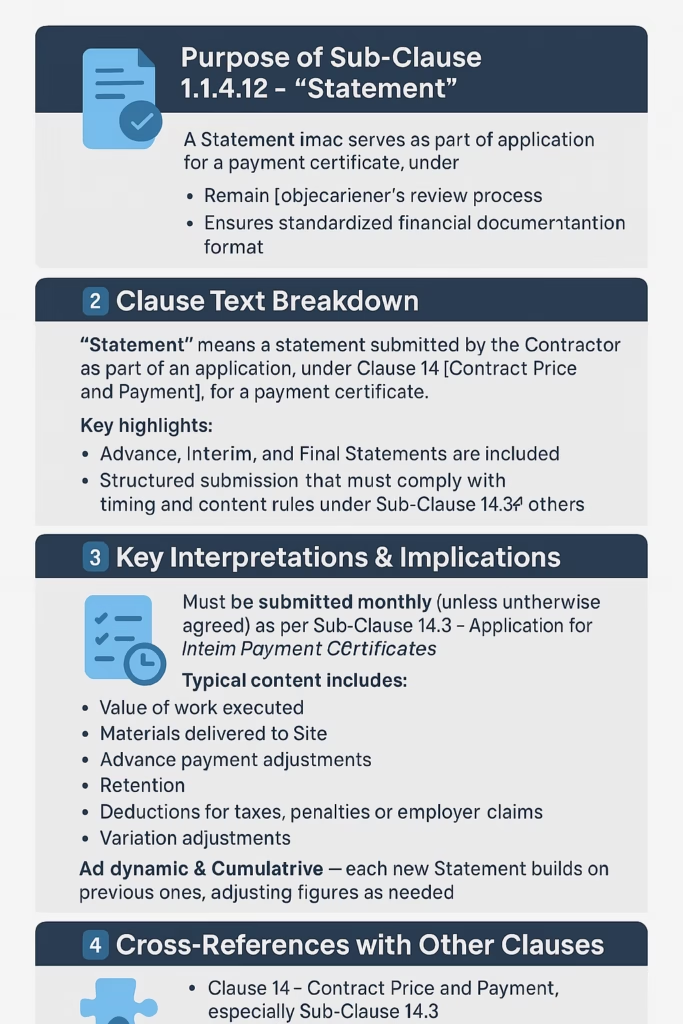![]()
🔹 1️⃣ Purpose of Sub-Clause 1.1.4.1 – “Accepted Contract Amount”
- What it defines: This clause introduces a fundamental financial definition in the contract:
“Accepted Contract Amount” means the amount accepted in the Letter of Acceptance for:- the execution and completion of the Works, and
- the remedying of any defects.
- Why it matters:
- Sets the baseline value for the project.
- Becomes the reference point for many other provisions—like performance security, delay damages, and final account evaluations.
- Crucial for determining maximum liabilities, insurance, and retention calculations.
- 🎯 Implication for the parties:
- Employer: Offers budgetary control and clarity on financial commitments.
- Contractor: Anchors financial planning, pricing risk, and security obligations.
- Any deviation from this amount (e.g., due to Variations) doesn’t affect the definition but affects the actual Contract Price (see Sub-Clause 1.1.4.2).
🔹 2️⃣ Breakdown of Sub-Clause 1.1.4.1
📖 Text of the clause (verbatim):
“‘Accepted Contract Amount’ means the amount accepted in the Letter of Acceptance for the execution and completion of the Works and the remedying of any defects.”
- Key Phrases:
- “Accepted”: This emphasizes the mutual agreement between the parties.
- “Letter of Acceptance”: A formal document that sets the legal foundation for the contract.
- “Execution and completion of the Works”: Covers design, procurement, construction, and commissioning.
- “Remedying of any defects”: Includes obligations during the Defects Notification Period (Clause 11).
🔹 3️⃣ Key Interpretations and Implications
- ✅ Fixed reference value: This amount is fixed at contract award. It does not change with variations, fluctuations, or claims—it remains the contractual reference.
- ⚖️ Used for calculations such as:
- Performance Security (Clause 4.2),
- Delay damages (Clause 8.7),
- Advance Payment (Clause 14.2),
- Limitation of Liability (Clause 17.6).
- ❗ Not to be confused with the “Contract Price” (Sub-Clause 1.1.4.2), which includes variations and adjustments.
🔹 4️⃣ Cross-Referencing with Other Clauses 🧩
- Clause 14.1 – Contract Price: This clause builds on the Accepted Contract Amount to define how the actual price evolves through variations, cost changes, etc.
- Clause 4.2 – Performance Security: Often expressed as a percentage of the Accepted Contract Amount.
- Clause 8.7 – Delay Damages: Calculated per day based on a percentage of this amount.
- Clause 17.6 – Limitation of Liability: Caps the contractor’s liability based on this amount if not otherwise stated.

🔹 1️⃣ Purpose of Sub-Clause 1.1.4.2 – “Contract Price”
- What it defines: This clause introduces the definition of “Contract Price,” which goes beyond the static value in the Letter of Acceptance.
- It recognizes the dynamic nature of construction projects—Contract Price includes variations, adjustments, and claims during the contract lifecycle.
- 🎯 Why it matters:
- It’s the actual amount payable to the Contractor for executing, completing, and remedying defects in the Works.
- Unlike the “Accepted Contract Amount” (Clause 1.1.4.1), this figure fluctuates throughout the project.
- It governs key financial obligations including interim payments, final payments, and claims.
🔹 2️⃣ Breakdown of the Clause 📖
“‘Contract Price’ means the price defined in Sub-Clause 14.1 [The Contract Price], and includes adjustments in accordance with the Contract.”
Key Elements:
- ✅ Defined in Sub-Clause 14.1: This clause houses the actual operational rules about how the Contract Price is determined and adjusted.
- 🔄 Includes adjustments: Such as:
- Variations (Clause 13),
- Claims under Clause 20,
- Adjustments for changes in cost (Clause 13.8),
- Currency fluctuation, provisional sums, and more.
🔹 3️⃣ Key Interpretations & Implications
- Distinction:
- Accepted Contract Amount: Fixed, as per Letter of Acceptance.
- Contract Price: Live, adjustable value based on actual project progress, claims, and approvals.
- Impacts:
- Basis for payments (Sub-Clauses 14.3 to 14.13).
- Delay damages, advance payment recovery, and price escalation are tied to this amount.
- If a dispute arises over payments, this is the reference point for quantification.
- Interpretative Question:
Can the Contract Price ever be lower than the Accepted Contract Amount?
👉 Yes, especially in cases involving omissions, terminations, or defects not remedied—see Clause 11.4.

🔹 4️⃣ Cross-Referencing with Other Clauses 🧩
- 🔗 Clause 14.1 – The Contract Price: Direct reference for understanding the pricing mechanics.
- 🔗 Clause 13 – Variations and Adjustments: Adjustments are part of the Contract Price computation.
- 🔗 Clause 20 – Claims: Entitlements under this clause (approved claims) affect the Contract Price.
- 🔗 Clause 11.4 – Failure to Remedy Defects: May result in a reduction of the Contract Price.
🔹 1️⃣ Purpose of Sub-Clause 1.1.4.3 – “Cost”
- Definition role: This sub-clause lays the foundation for interpreting any reference to “Cost” throughout the contract. It’s not just a casual word—it’s a defined term with contractual weight.
- ✅ Why it matters:
- Used extensively in claims, variations, prolongation, and payment disputes.
- Dictates what the Contractor can recover under circumstances like delays or Employer’s breaches.
- 👥 For whom is this important?
- Contractors: To understand what they can claim.
- Employers: To know what they’re liable to pay.
- Engineers: To determine and evaluate costs.
🔹 2️⃣ Breakdown of the Clause 📖
“Cost” means all expenditure reasonably incurred (or to be incurred) by the Contractor, whether on or off the Site, including overhead and similar charges, but does not include profit.
Key Components:
- 💰 “All expenditure reasonably incurred”: Not just invoices—this includes internal costs, logistics, and site-related spending.
- 🏗️ “On or off the Site”: Covers full project operations—even remote offices, warehouses, or consultant fees.
- 🔁 “To be incurred”: Includes future cost projections tied to approved entitlements.
- 🚫 “But does not include profit”: This is huge! It explicitly excludes any mark-up—profit needs to be separately approved (often under the phrase “Cost plus reasonable profit”).
🔹 3️⃣ Key Interpretations and Implications
- 🔄 Used in almost every claim: Whether it’s time-related or event-triggered (like suspension, force majeure), “Cost” is the bedrock for financial entitlement.
- ⚠️ No automatic right to profit:
- If profit is sought, it must be explicitly allowed in that clause (e.g., Clause 20.1 or Clause 13.2).
- 📋 Reasonableness test:
- The term “reasonably incurred” places a burden of justification on the Contractor.
- Cost needs to be proven, not just claimed.
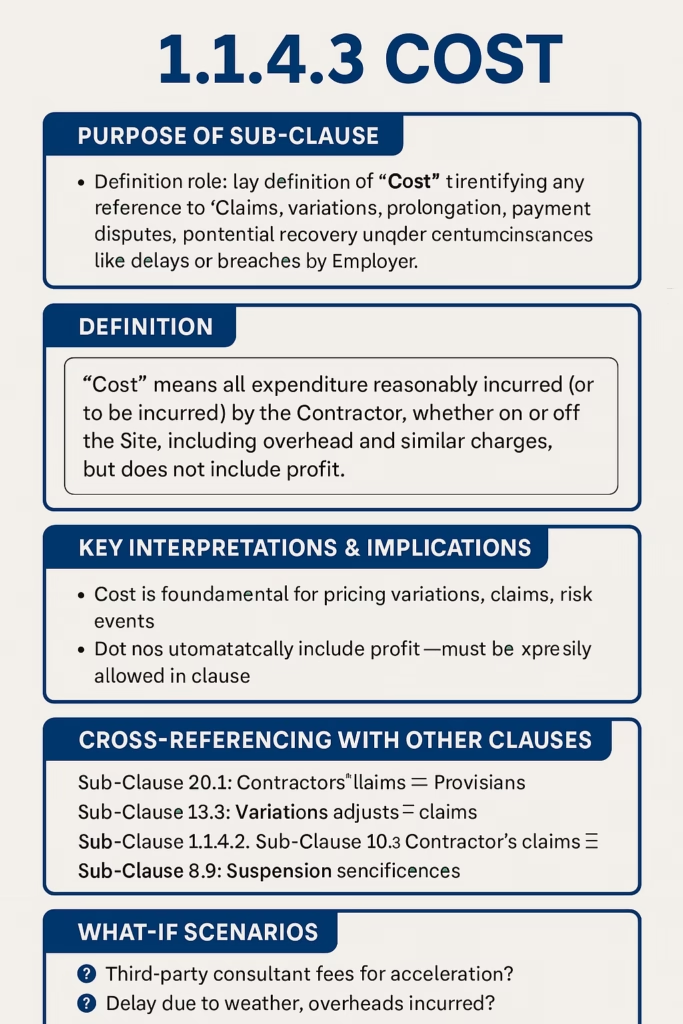
🔹 4️⃣ Cross-Referencing with Other Clauses 🧩
- Sub-Clause 20.1 – Contractor’s Claims: “Cost plus reasonable profit” may be allowed for certain Employer-caused delays.
- Sub-Clause 13.3 – Variations: Pricing may be based on actual Cost or agreed rates.
- Sub-Clause 1.1.4.2 – Contract Price: Adjustments due to Cost (but without profit) impact the Contract Price.
- Sub-Clause 8.9 – Suspension: Entitles the Contractor to Cost if the suspension is not due to his default.
🔹 5️⃣ What-If Scenarios
🔸 What if the Contractor incurs third-party consultant fees for acceleration requested by the Engineer?
→ These could be claimed as “Cost,” if reasonable and supported by documentation.
🔸 What if a delay occurs due to weather, and the Contractor incurs overheads?
→ If the delay qualifies under a relevant clause (e.g., 8.4), the overheads may be claimed as part of “Cost”—but not profit.
🔸 What if the Contractor claims for unquantified future expenses?
→ “Cost to be incurred” is allowed—but only when reasonably forecast and backed with evidence or logic.
🔹 1️⃣ Purpose of Sub-Clause 1.1.4.4 – “Final Payment Certificate”
- What it defines: This clause provides the meaning of a “Final Payment Certificate”, marking the contractual closure of payment obligations between the Employer and Contractor (except for any outstanding or deferred obligations).
- It’s a key milestone in concluding the financial relationship under the contract.
- 🎯 Why it matters:
- Certifies that the Contractor has fulfilled all obligations and is entitled to the final amount due.
- Triggers payment of the final balance, if any.
- Signifies a point beyond which no further payment certificates will be issued under the Contract (except as per legal rights or unfulfilled obligations).
🔹 2️⃣ Breakdown of the Clause 📖
“Final Payment Certificate” means the payment certificate issued under Sub-Clause 14.13 [Issue of Final Payment Certificate].
Breakdown:
- 🔗 Reference to Clause 14.13 is critical because that’s where the process and criteria for issuing this certificate are detailed.
- It’s not merely symbolic—it is a formal declaration by the Engineer that:
- The Final Statement has been reviewed,
- All payments, adjustments, and claims are accounted for,
- And both Parties are nearing contractual closure.
🔹 3️⃣ Key Interpretations & Implications
- 🧾 Based on the Final Statement (defined in Sub-Clause 1.1.4.5).
- ❌ No further entitlement to additional amounts unless:
- There’s a contractual dispute or
- There are unfulfilled obligations under Clause 11.10 (Unfulfilled Obligations).
- ⏱️ Time trigger: The certificate is issued within 28 days of the Engineer receiving the Final Statement and supporting documentation (Clause 14.13).

🔹 4️⃣ Cross-Referencing with Other Clauses 🧩
- Sub-Clause 14.13 – Issue of Final Payment Certificate: Core procedure for issuance.
- Sub-Clause 14.11 – Application for Final Payment Certificate: Contractor’s obligation to apply with a Final Statement.
- Sub-Clause 11.10 – Unfulfilled Obligations: Even after the Final Payment Certificate, some obligations may still continue.
- Sub-Clause 20.1 – Contractor’s Claims: If claims are submitted late or unapproved before finalization, they may be barred unless they fall under continuing obligations.
🔹 5️⃣ What-If Scenarios
🔸 What if the Contractor forgets to include an item in the Final Statement?
→ The Engineer may not include it in the Final Payment Certificate unless it’s a continuing obligation.
🔸 What if a claim is still under dispute?
→ The disputed amount may be withheld or excluded, pending resolution under Clause 20 (Disputes).
🔸 What if the Contractor submits the Final Statement late?
→ The Engineer’s obligation to certify is not triggered until it is properly submitted.
🔹 1️⃣ Purpose of Sub-Clause 1.1.4.5 – “Final Statement”
- 🧾 What it defines: This clause identifies what is meant by the term Final Statement, a crucial financial document in the contract close-out phase.
- 🎯 Why it matters:
- It’s the Contractor’s formal submission for final payment after the Works are completed and all known claims are submitted.
- It kicks off the procedure for the Engineer to issue the Final Payment Certificate.
- Acts as the financial “wrap-up” of the project, consolidating all claims, changes, and entitlements.
- 👥 Relevant to:
- Contractors: Must ensure that it captures all costs and entitlements.
- Employers: Used to assess final liabilities.
- Engineers: It starts their duty to certify under Sub-Clause 14.13.
🔹 2️⃣ Clause Text Breakdown 📖
“Final Statement” means the statement defined in Sub-Clause 14.11 [Application for Final Payment Certificate].
- It refers directly to Sub-Clause 14.11, which outlines:
- What the Final Statement should include,
- When and how it must be submitted,
- The documentation to accompany it.
🔹 3️⃣ Key Interpretations & Implications
- 📌 The Final Statement must include:
- The total amount the Contractor believes is due under the Contract.
- All items that have been agreed upon or are pending determination.
- All claims, variations, and adjustments to the Contract Price.
- ⏰ Timing is critical:
- The Final Statement must be submitted within 84 days after receiving the Taking-Over Certificate for the whole Works (unless agreed otherwise in writing).
- ⚠️ Late or incomplete Final Statements can delay or prevent issuance of the Final Payment Certificate under Clause 14.13.

🔹 4️⃣ Cross-References with Other Clauses 🧩
- Sub-Clause 14.11 – Application for Final Payment Certificate: Governs how and when the Final Statement must be submitted.
- Sub-Clause 14.13 – Issue of Final Payment Certificate: Can only proceed after receiving and verifying the Final Statement.
- Sub-Clause 20.1 – Contractor’s Claims: All claims to be included in Final Statement or risk being time-barred.
- Clause 11.10 – Unfulfilled Obligations: Even after the Final Statement, the contract remains alive for any remaining duties.
🔹 5️⃣ What-If Scenarios
🔸 What if the Contractor fails to submit a Final Statement within the 84 days?
→ The Engineer is not obligated to issue a Final Payment Certificate until it’s received.
🔸 What if a claim is ongoing when the Final Statement is submitted?
→ It should still be included in the Final Statement and marked as “pending determination.”
🔸 What if a dispute arises over the contents of the Final Statement?
→ Clause 20 (Claims & Disputes) provides the mechanism for resolution, including DAB referral.
🔹 1️⃣ Purpose of Sub-Clause 1.1.4.6 – “Foreign Currency”
- 💱 Definition Purpose: This clause introduces a key commercial term used throughout the contract where payments may not be in the local currency.
- Why it’s important:
- Enables multi-currency contracts, often essential for international projects involving overseas Contractors or imported goods.
- Assures the Contractor of payment in agreed foreign denominations—minimizing exchange rate risk.
- 🧩 This clause supports financial clarity where the Contract Price includes amounts payable in more than one currency.
🔹 2️⃣ Clause Text Overview 📖
“Foreign Currency” means a currency other than the Local Currency. One particular Foreign Currency may be required.
✅ Key Points:
- 📌 “Local Currency” is separately defined (in Sub-Clause 1.1.4.7).
- The clause suggests that only one Foreign Currency may be required, although more could be specified in the Appendix to Tender or Particular Conditions.
🔹 3️⃣ Key Interpretations & Implications
- 🔄 Used in calculations and payment breakdowns, especially for:
- Advance payments (Clause 14.2),
- Interim Payment Certificates (Clause 14.6),
- Final Payment Certificates (Clause 14.13),
- Performance Security amounts (Clause 4.2).
- 💬 The choice of currency must be clearly stated and agreed before contract signing. It is not left open to later interpretation.
- 🔐 This ensures the Contractor knows exactly what currency will be received, guarding against inflation or devaluation in the project’s country.
🔹 4️⃣ Cross-References with Other Clauses 🧩
- Sub-Clause 1.1.4.7 – Local Currency: Directly related—this clause sets the contrast to Foreign Currency.
- Sub-Clause 14.1 – Contract Price: Often broken down by currency proportions (local + foreign).
- Appendix to Tender: Usually includes a table stating currency splits.
- Sub-Clause 14.2 – Advance Payment: Advance amounts are commonly paid in the same proportions as the Contract Price currencies.
🔹 5️⃣ What-If Scenarios
🔸 What if the Employer tries to pay the entire Contract Price in Local Currency despite the Contract specifying a Foreign Currency?
→ This would likely be a breach of contract, and the Contractor may raise a claim under Clause 20.1.
🔸 What if exchange controls in the Country restrict outgoing foreign payments?
→ The Employer would still be obligated under the Contract but may face legal challenges—this risk must be assessed during tendering.
🔸 Can more than one Foreign Currency be used?
→ Yes, if defined in the Contract documents. The wording in 1.1.4.6 only mentions “one particular” currency may be required, not that more cannot be.
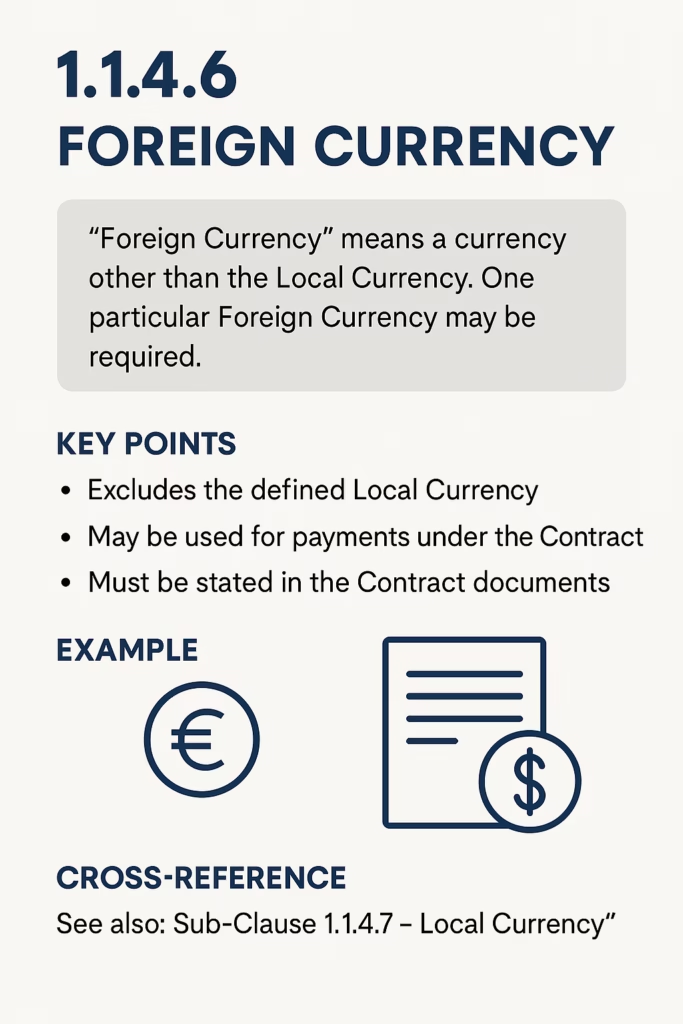
🔹 1️⃣ Purpose of Sub-Clause 1.1.4.7 – “Interim Payment Certificate”
- 💰 Why it exists: This clause introduces a formal definition for the Interim Payment Certificate—a critical tool used throughout the construction period to process regular payments to the Contractor.
- 🎯 What it does:
- Forms the basis for progress payments under Clause 14 [Contract Price and Payment].
- Recognizes that payments are made at intervals before project completion.
- Ensures structured cash flow, preventing payment only at the end.
🔹 2️⃣ Clause Text Breakdown 📖
“Interim Payment Certificate” means a payment certificate issued under Clause 14, other than the Final Payment Certificate.
✅ Key Terms:
- “Other than the Final Payment Certificate”: Indicates that this applies to all certificates issued prior to the final settlement under Sub-Clause 14.13.
- Tied to Clause 14: This includes Sub-Clauses like:
- 14.3 – Application for Interim Payment Certificate
- 14.6 – Issue of Interim Payment Certificate
🔹 3️⃣ Key Interpretations & Implications
- 💵 Issued Monthly or at Agreed Intervals: Often linked to a monthly payment cycle, based on progress of Works.
- 📝 Engineer’s Review Role:
- The Contractor submits an application (Sub-Clause 14.3),
- The Engineer verifies and certifies payment (Sub-Clause 14.6).
- ⚖️ Not conclusive evidence: These certificates do not imply final acceptance or settlement. Adjustments can still happen in later certificates.

🔹 4️⃣ Cross-Referenced Clauses 🧩
- Sub-Clause 14.3 – Application for Interim Payment Certificates: The Contractor’s detailed breakdown of amounts claimed.
- Sub-Clause 14.6 – Issue of Interim Payment Certificate: Engineer’s obligations for verifying and certifying the amount due.
- Sub-Clause 14.13 – Final Payment Certificate: The defining opposite—issued after full completion and acceptance.
- Clause 20 – Claims: Any additional entitlement outside of regular progress payments must follow this procedure.
🔹 5️⃣ What-If Scenarios
🔸 What if the Contractor makes an error in the application?
→ The Engineer can correct or reduce the certified amount under Sub-Clause 14.6.
🔸 What if the Employer delays payment after certification?
→ The Contractor may claim financing charges under Sub-Clause 14.8 [Delayed Payment].
🔸 What if quantities change dramatically?
→ Adjustments are reflected in the next Interim Payment Certificate, or dealt with via Clause 13 – Variations.
🔹 1️⃣ Purpose of Sub-Clause 1.1.4.8 – “Local Currency”
- 🌍 What it defines: The clause provides a specific definition for “Local Currency,” which is fundamental for all contracts involving multiple currencies or international parties.
- 🎯 Why it’s important:
- Serves as the default currency of payment, valuation, and pricing within the host country where the project is located.
- Helps define financial obligations in the native economic context of the country of execution.
- 👥 Relevant to:
- Employers: For budgeting and controlling local expenditure.
- Contractors: For complying with local tax laws, payroll, and procurement.
- Engineers and Auditors: For accounting and pricing compliance.
🔹 2️⃣ Text Breakdown 📖
“Local Currency” means the currency of the Country.”
- ✅ Short, precise, and cross-referenced with “Country,” which is separately defined in Sub-Clause 1.1.6.2.
- 🔁 “Local Currency” is used to:
- Split the Contract Price between foreign and local portions.
- Determine retention money, advances, and taxes.
🔹 3️⃣ Key Interpretations & Implications
- 🧾 Impacts how the Contract Price is structured:
- Most contracts will specify a percentage of the Contract Price payable in Local Currency and the rest in Foreign Currency (see Sub-Clause 14.1 and Appendix to Tender).
- 💬 In cases where the Local Currency is unstable (due to inflation, etc.), the risk is usually carried by the Contractor—unless adjusted via Sub-Clause 13.8.
- ⚠️ Contractual clarity is essential:
- The term must be consistent with the “Country” defined.
- All financial documents, such as Interim Payment Certificates, must clearly distinguish amounts in Local vs. Foreign Currency.
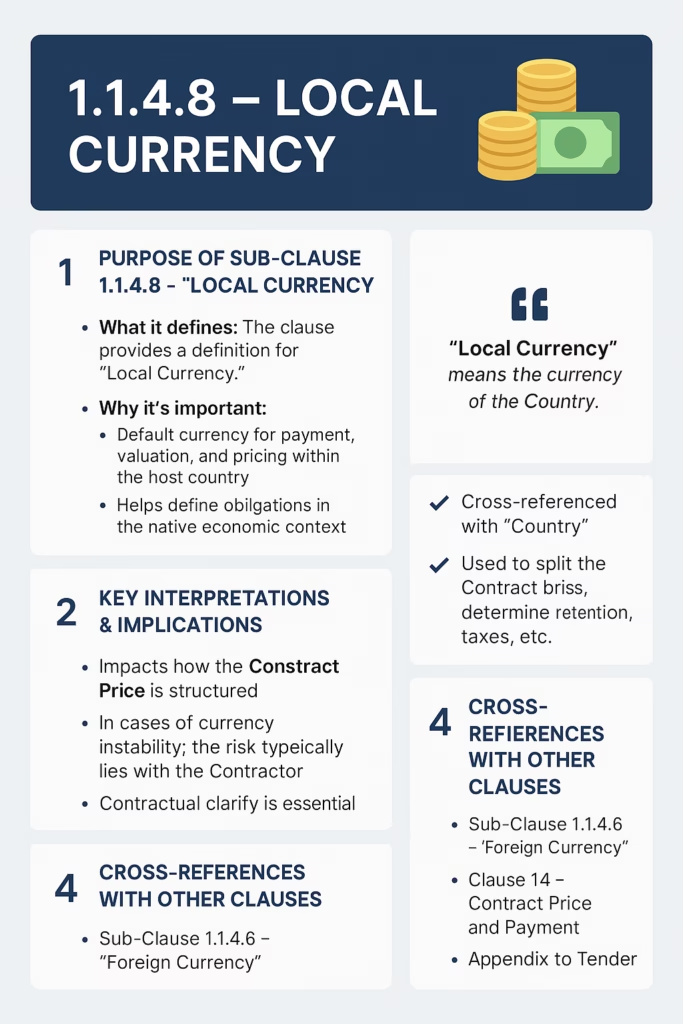
🔹 4️⃣ Cross-References with Other Clauses 🧩
- Sub-Clause 1.1.4.6 – Foreign Currency: Works in contrast to Local Currency; the two are often used together in pricing schedules.
- Clause 14 – Contract Price and Payment: Most references to currency splits occur here, particularly in:
- 14.1 – Contract Price
- 14.2 – Advance Payment
- 14.6 – Interim Payment Certificate
- Appendix to Tender: Lists the currency proportions for payments.
🔹 5️⃣ What-If Scenarios
🔸 What if a government changes its currency (e.g., due to redenomination)?
→ The “Local Currency” definition would automatically apply to the new national currency, unless specifically varied in the Particular Conditions.
🔸 What if the Contract specifies Local Currency for payment but does not define the Country?
→ This may lead to ambiguity and could become a dispute point if project jurisdiction is unclear.
🔸 Can Local Currency include multiple types (e.g., regional & national currencies)?
→ No. It strictly means the currency of the defined Country under the contract.
🔹 1️⃣ Purpose of Sub-Clause 1.1.4.9 – “Payment Certificate”
- 💵 Definition Scope: This clause defines what is meant by a “Payment Certificate”—a central instrument used throughout the contract to certify payments due from the Employer to the Contractor.
- 🎯 Why it matters:
- It’s the official confirmation by the Engineer of the amount payable.
- Without a Payment Certificate, the Employer is not obligated to pay.
- It ensures payment claims are substantiated, verified, and contractually approved.
🔹 2️⃣ Clause Text Breakdown 📖
“Payment Certificate” means a payment certificate issued under Clause 14 [Contract Price and Payment].
✅ This definition serves as a generic umbrella for all types of Payment Certificates, including:
- Advance Payment Certificate (Sub-Clause 14.2),
- Interim Payment Certificates (Sub-Clause 14.6),
- Final Payment Certificate (Sub-Clause 14.13).
🧩 The specific form and procedure for each type of Payment Certificate is detailed in the relevant sub-clauses of Clause 14.
🔹 3️⃣ Key Interpretations & Implications
- 🧾 Not a guarantee of payment by itself:
- A Payment Certificate is an acknowledgment of entitlement, but payment still depends on the Employer’s financial standing and Clause 14.7 (Time for Payment).
- 🕒 Triggers time obligations:
- The date of issuance starts the countdown for when the Employer must pay (usually within 56 days under Sub-Clause 14.7 unless amended).
- 🔐 Legal safeguard:
- Issuance of a Payment Certificate limits disputes—it’s a neutral Engineer-led process that validates claims.
🔹 4️⃣ Cross-Referenced Clauses 🧩
- Clause 14 – Contract Price and Payment:
- This is the central operational framework for all payment-related procedures.
- Sub-Clause 14.2 – Advance Payment: Leads to an advance payment certificate.
- Sub-Clause 14.6 – Interim Payment Certificate: Issued monthly for progress payments.
- Sub-Clause 14.13 – Final Payment Certificate: Closes financial obligations after Final Statement.
- Clause 20 – Claims: Any unapproved claims must be pursued separately and don’t form part of the Payment Certificate automatically.
🔹 5️⃣ What-If Scenarios
🔸 What if the Engineer delays issuing a Payment Certificate?
→ The Contractor can serve notice under Clause 20.1 (Contractor’s Claims) and may also be entitled to interest under Sub-Clause 14.8.
🔸 What if the Employer doesn’t pay even after certification?
→ The Contractor can suspend work (Sub-Clause 16.1) or terminate the contract (Sub-Clause 16.2).
🔸 Can the Employer dispute a Payment Certificate after it’s issued?
→ Generally no, unless fraud or error is proven. Otherwise, disputes must go through the DAB or arbitration process under Clause 20.
inal Takeaways 💡
| Item | Description |
|---|---|
| Definition | A formal certificate issued by the Engineer confirming the payment due |
| Types | Advance, Interim, Final |
| Governing Clause | Clause 14 |
| Triggers | Employer’s obligation to pay |
| Legal Weight | High—it is the basis for enforcing payment claims |
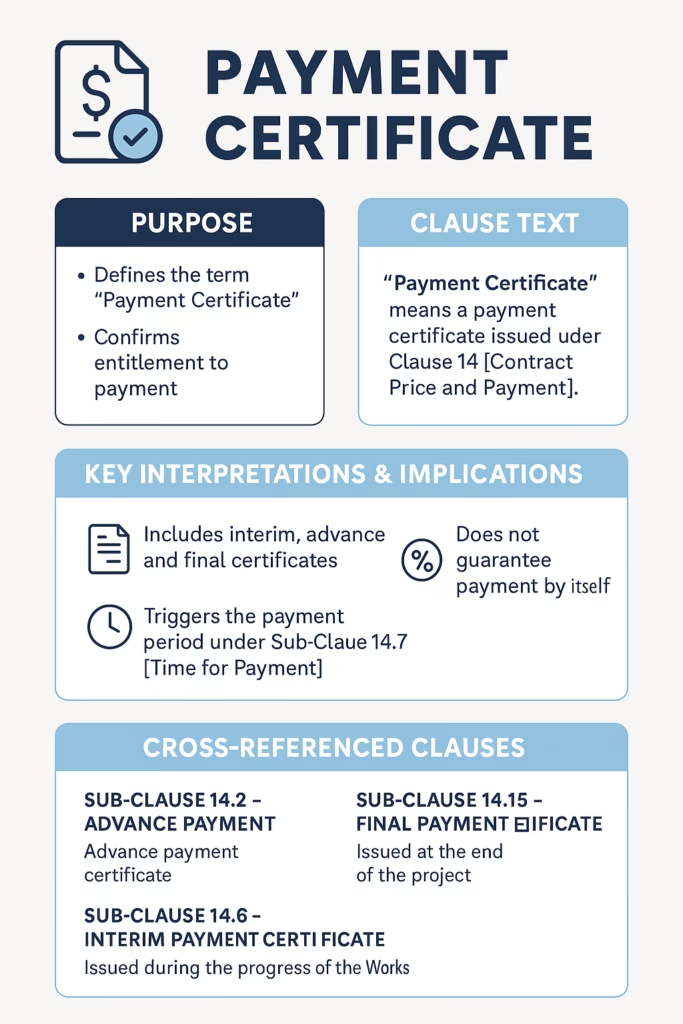
🔹 1️⃣ Purpose of Sub-Clause 1.1.4.10 – “Provisional Sum”
- 💼 Why it exists: A Provisional Sum is a placeholder in the Contract Price for works or items that are not clearly defined at tender stage. It’s a strategic allowance for unpredictable or discretionary work.
- 🎯 Key Objective:
- Provides budget flexibility without changing the Contract Price immediately.
- Allows the Employer (via the Engineer) to instruct work later without needing a full Variation process upfront.
- 👥 Who uses it:
- Employers: Use it to retain discretion over certain work scopes.
- Contractors: Must execute such works only upon instruction.
🔹 2️⃣ Clause Text Breakdown 📖
“Provisional Sum” means a sum (if any) which is specified in the Contract as a provisional sum, for the execution of any part of the Works or for the supply of Plant, Materials or services under Sub-Clause 13.5 [Provisional Sums].
Key Elements:
- 📦 “Specified in the Contract”: The Provisional Sum must be pre-listed in the Bill of Quantities or Pricing Schedule.
- 🔧 For execution/supply: Can be used for:
- Construction tasks,
- Equipment or Plant,
- Services (e.g., testing, third-party works).
🔹 3️⃣ Key Interpretations & Implications
- 🛠️ Engineer’s Control:
- The Contractor may not act on a Provisional Sum item until instructed by the Engineer.
- 🔍 Defined in Sub-Clause 13.5:
- Payment for Provisional Sums depends on:
- Instructions received,
- Actual cost incurred,
- Percentages for overheads/profit added as defined in the Appendix to Tender.
- Payment for Provisional Sums depends on:
- ⚖️ It’s not a claimable amount until work is done—having a Provisional Sum in the contract doesn’t grant entitlement unless it’s activated.
🔹 4️⃣ Cross-Referenced Clauses 🧩
- Sub-Clause 13.5 – Provisional Sums: Core procedure for how and when Provisional Sums are used and valued.
- Clause 14 – Contract Price and Payment: Governs how Provisional Sums are processed through Payment Certificates.
- Appendix to Tender: States the percentage to be applied to Provisional Sums (e.g., 10% OH + 5% profit).
🔹 5️⃣ What-If Scenarios
🔸 What if the Employer decides not to use a Provisional Sum?
→ Then no amount is added to the Contract Price. The sum remains unused.
🔸 What if the actual cost is more than the Provisional Sum?
→ The Contract Price is adjusted to reflect the actual value, subject to the Engineer’s determination under Sub-Clause 13.5.
🔸 What if the Contractor executes Provisional Sum work without instruction?
→ It may not be payable. Work must be initiated only upon instruction.
Final Takeaways 💡
| Element | Summary |
|---|---|
| Definition | A placeholder amount for undefined works/items |
| Not automatic | Only payable upon Engineer’s instruction |
| Valued under | Sub-Clause 13.5 |
| Purpose | Provides flexibility for discretionary/emerging scope |
| Payment trigger | Instruction + actual execution |
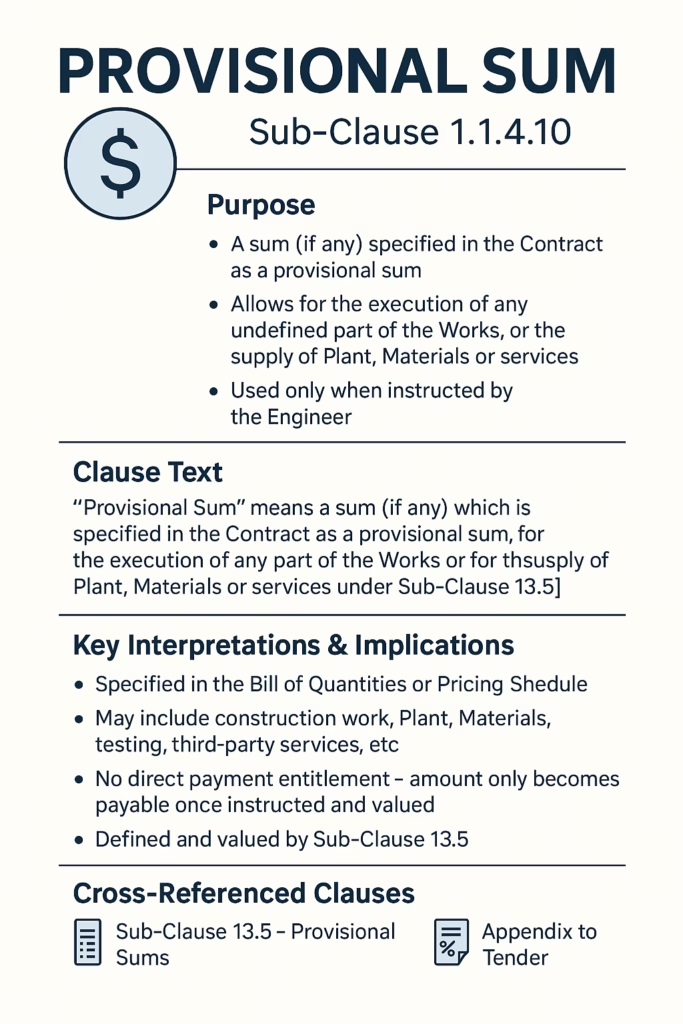
🔹 1️⃣ Purpose of Sub-Clause 1.1.4.11 – “Schedule of Payments”
- 📆 Why it’s important: This clause defines what a Schedule of Payments is—an essential planning and payment tool that specifies when and how the Contractor will be paid during the course of the Contract.
- 🎯 Main Objectives:
- Establishes pre-agreed payment milestones (instead of monthly valuations),
- Assures the Employer of payment control aligned with project stages,
- Helps the Contractor maintain cash flow predictability based on progress targets.
- 👥 Key users:
- Contractor: For billing and cash flow planning,
- Engineer: For verifying and certifying payments,
- Employer: For controlling disbursements tied to deliverables.
🔹 2️⃣ Clause Text Breakdown 📖
“Schedule of Payments” means the schedule stated in the Appendix to Tender and any revised schedule prepared by the Contractor and approved by the Engineer under Sub-Clause 14.4 [Schedule of Payments].
✅ This definition includes both:
- 📑 The initial schedule (included with the Tender), and
- ✍️ Any Engineer-approved revisions submitted later during contract execution.
🔹 3️⃣ Key Interpretations & Implications
- 🔄 Dynamic & Adjustable:
- The Contractor may propose updates, but approval by the Engineer is mandatory.
- Schedule must align with actual progress and sequencing of the Works.
- 💵 Used in milestone-based contracts:
- Payments are linked to completion of specific work sections or deliverables, not just time-based progress.
- Must reflect realistic and measurable outputs to avoid disputes.
- 🔒 Binding Framework:
- Once approved, the Employer is obligated to pay according to the certified milestones in the schedule.
🔹 4️⃣ Cross-Referenced Clauses 🧩
- Sub-Clause 14.4 – Schedule of Payments:
- Details the procedure for submission and revision of the Schedule.
- Sub-Clause 14.3 – Application for Interim Payment Certificate:
- Ties the payment application process directly to the agreed schedule.
- Appendix to Tender:
- The original Schedule of Payments is typically included here.
- Clause 4.1 – Contractor’s General Obligations:
- Requires execution in accordance with all approved documents, including payment schedules.
🔹 5️⃣ What-If Scenarios
🔸 What if the Contractor doesn’t submit a revised Schedule despite changed circumstances?
→ The Engineer may withhold or delay payment certification under Sub-Clause 14.6, citing inconsistency.
🔸 What if progress doesn’t match the payment milestone?
→ Payment may be withheld or adjusted until the milestone is achieved and certified.
🔸 Can the Employer unilaterally revise the schedule?
→ No. Only the Contractor can propose a revised schedule, and the Engineer must approve it.
Final Takeaways 💡
| Topic | Summary |
|---|---|
| What it is | A timeline or milestone-based payment plan |
| Set by | Contractor (initial or revised), approved by Engineer |
| Used for | Determining when payments are due |
| Legal weight | Forms a binding structure for progress-linked payments |
| Flexibility | Can be revised with proper justification and Engineer’s approval |
📌 Pro Tip: For projects with uneven cash flow or staged deliverables, always ensure the Schedule of Payments matches the actual resource deployment and execution plan 🧾.
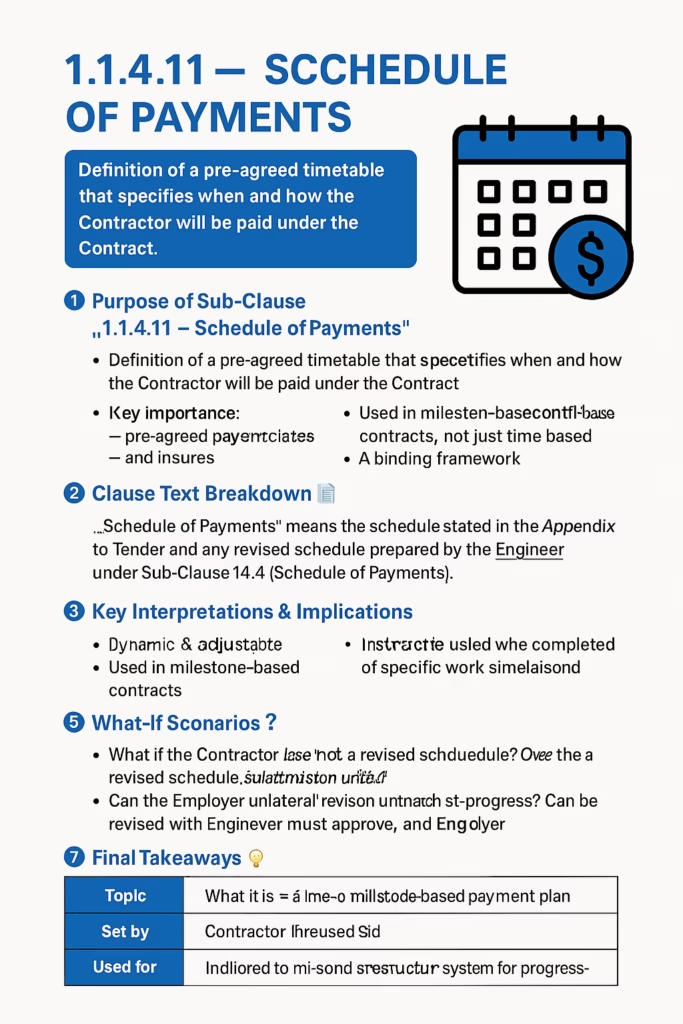
🔹 1️⃣ Purpose of Sub-Clause 1.1.4.12 – “Statement”
- 🧾 Definition Role: This clause defines what a “Statement” means in the context of project payments.
- 🎯 Main Objective:
- Serves as the Contractor’s formal request for payment, submitted in accordance with Clause 14 [Contract Price and Payment].
- It triggers the Engineer’s review and certification process.
- Ensures there’s a standardized format for financial documentation.
- 👥 Who it matters to:
- Contractor: To claim progress payments.
- Engineer: To assess compliance and issue Payment Certificates.
- Employer: For processing and releasing funds.
🔹 2️⃣ Clause Text Breakdown 📖
“Statement” means a statement submitted by the Contractor as part of an application, under Clause 14 [Contract Price and Payment], for a payment certificate.
📌 Highlights:
- It includes Advance Payment Statements, Interim Statements, and Final Statements.
- Structured submission that must comply with timing and content rules under Sub-Clause 14.3 and others.
🔹 3️⃣ Key Interpretations & Implications
- 📅 Must be submitted monthly (unless otherwise agreed) per Sub-Clause 14.3 – Application for Interim Payment Certificates.
- 📋 Typical content includes:
- Value of work executed,
- Materials delivered to Site,
- Advance payment adjustments,
- Retention,
- Deductions for taxes, penalties, or employer claims,
- Variation adjustments,
- Supporting documentation.
- 🔁 Dynamic & Cumulative: Each new Statement builds on previous ones, adjusting figures as needed.
🔹 4️⃣ Cross-References with Other Clauses 🧩
- Clause 14 – Contract Price and Payment:
- Especially Sub-Clause 14.3, which dictates how Statements are to be formatted and submitted.
- Sub-Clause 14.11 – Application for Final Payment Certificate:
- Final Statement is the last and most critical Statement in the contract lifecycle.
- Sub-Clause 20.1 – Contractor’s Claims:
- Additional amounts not included in routine Statements must follow this claims procedure.
🔹 5️⃣ What-If Scenarios
🔸 What if the Contractor fails to submit a Statement on time?
→ The Engineer may delay issuing the Payment Certificate, which could impact cash flow.
🔸 What if an item is missed in a Statement?
→ It can be added in a subsequent Statement, but may raise disputes if it relates to completed work or expired claim periods.
🔸 What if the Statement includes unsubstantiated claims?
→ The Engineer may reject or reduce the claimed amount under Sub-Clause 14.6, and request clarification.
Final Takeaways 💡
| Topic | Summary |
|---|---|
| Definition | A formal document submitted by the Contractor to request payment |
| Used in | All stages: advance, interim, final payments |
| Reviewed by | The Engineer, who then issues the Payment Certificate |
| Basis for | Cash flow, progress verification, claim processing |
| Risk | Incorrect/incomplete Statements can delay payments 🛑 |
📌 Pro Tip: A well-prepared Statement backed by solid documentation is the fastest route to securing your payment on time 💼.
